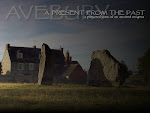Events at Avebury. December 2009 - February 2010
Anti-lovers walk: 14 February, 10.30am – 12.30pm.
Discover the Avebury Landscape: 18 February, 10.30am – 1pm.
More here – http://www.nationaltrust.org.uk/eventsNet/default.aspx?propertyID=316
Diamonds are forever (hopefully)

"A coach penetrating deep into the sacred heart of the Avebury complex, never right!" Image credit Arcturus

But for how much longer will this 'diamond' from our megalithic past remain unmoved, let alone undamaged? The Diamond Stone sits perilously close to the Swindon-bound A4361 that runs through Avebury, indeed one corner of the stone hangs over the fence between the grass verge and the road itself and is subject to constant (and during the morning and evening rush hours heavy) vibration from passing traffic. It is astonishing that the local authorities have only recently introduce a 30 mile an hour speed limit through Avebury but is this enough to reduce vibration to the stone let alone minimize damage to it should it be hit by a passing car, bus or heavy goods vehicle?

The Diamond Stone at the edge of the Swindon-bound A4361. Image credit Moss
There has been an appalling amount of destruction of, and damage to, the Avebury megaliths over recent centuries, and the Diamond Stone is sadly yet another tragedy waiting to happen there - let's act now to protect this monument from our ancient past from similar damage before it is too late!
Obituaries. Professor Humphrey Kay

"On retirement from the medical world he effectively began a second career – as a naturalist – inspired by his childhood love of wildlife and the environment. It wasn't long before he made a name for himself in this field too.
"His colleagues recall that, even though he came to it late, Kay was a born naturalist with an enthusiastic, inquiring mind and a keen eye. He became an active member of the Wiltshire Wildlife Trust and was elected to its council in 1983.
"One of the trust's most valuable fund-raising activities arose from his simple but original idea of a sponsored walk from Avebury to Stonehenge each May Day holiday. He would also take groups of Marlborough College boys on excursions into nearby Savernake Forest, organising moth trapping surveys at night."
More here -
http://www.telegraph.co.uk/news/obituaries/medicine-obituaries/6729112/Professor-Humphrey-Kay.html



